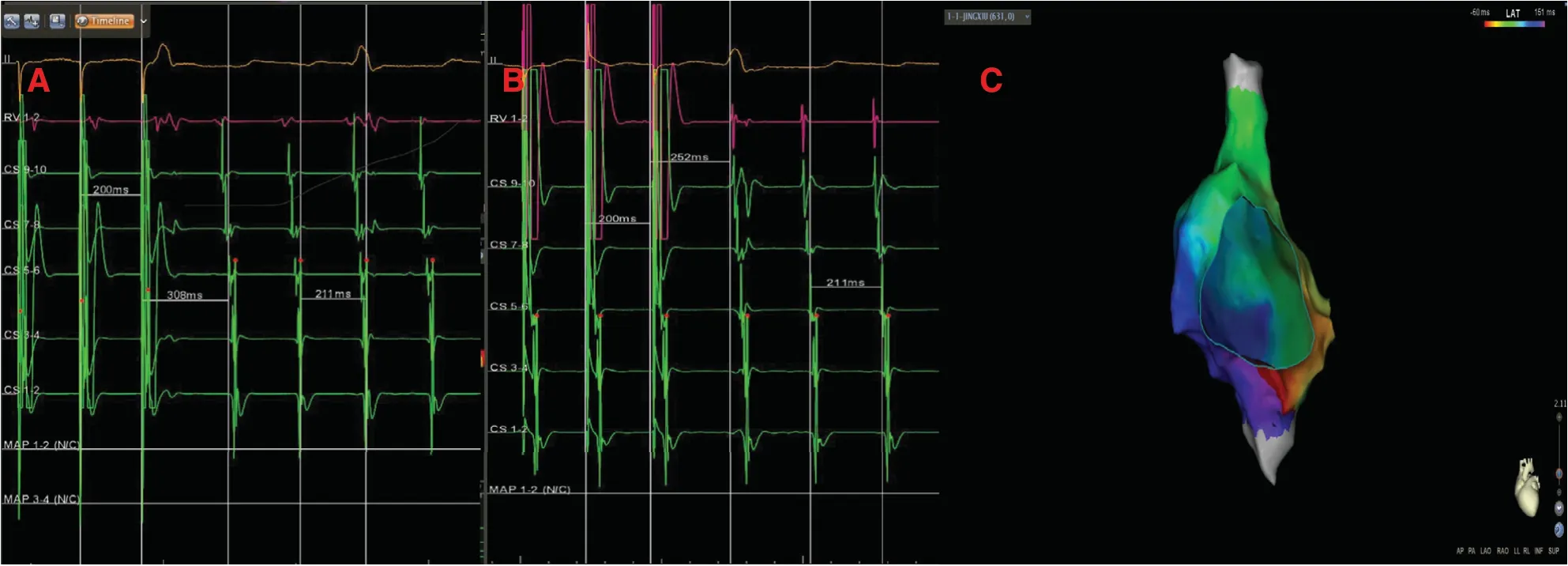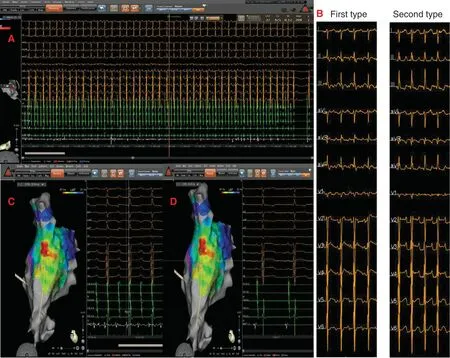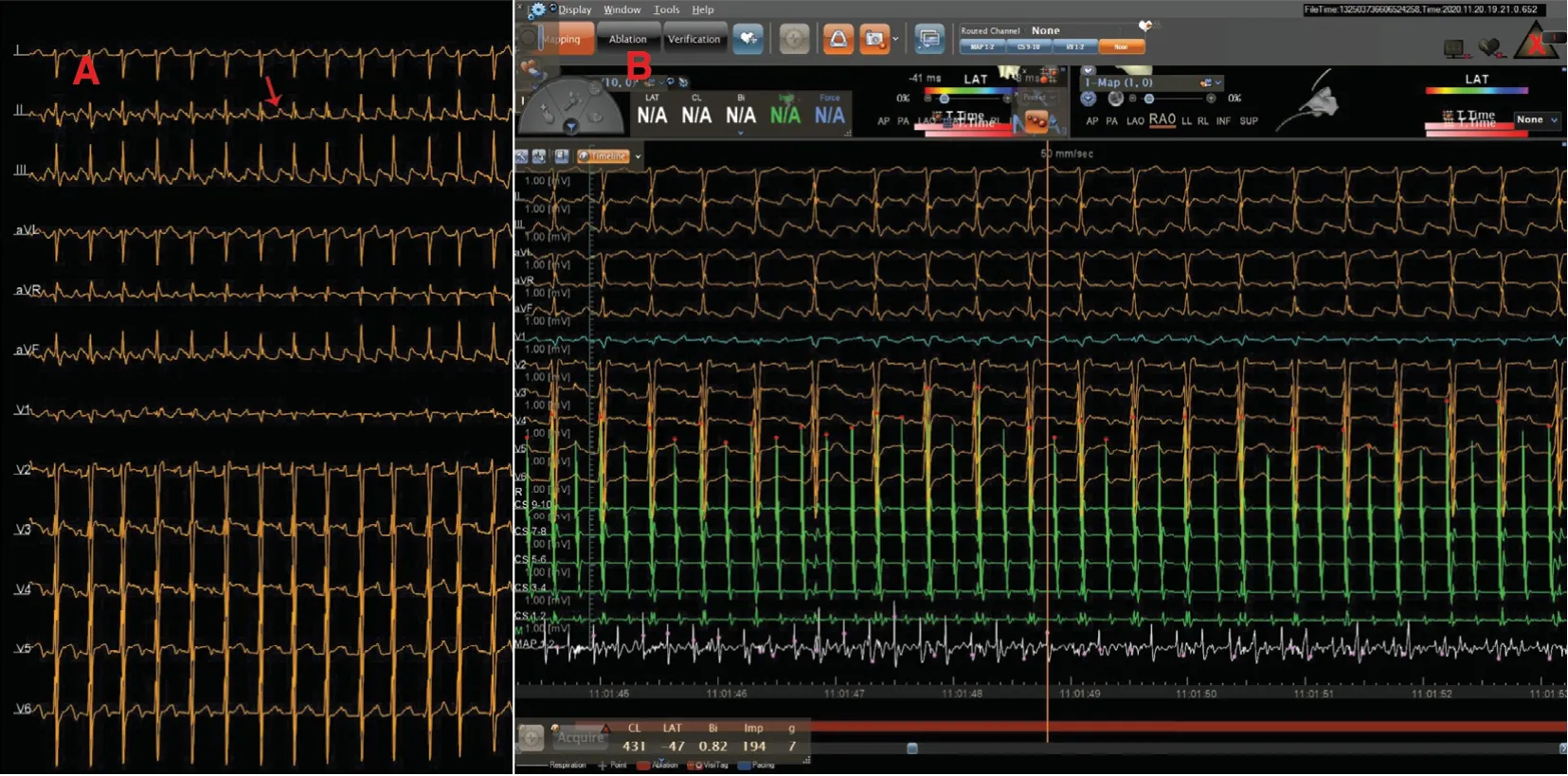A Case Report of Radiofrequency Ablation of Typical Atrial Flutter Combined with Atrial Tachycardia
Chen Chun-hui and Ning Li-ye
1 Cardiovascular Medicine Department, Dongguan Kanghua Hospital, Dongguan 523000, China
Abstract A 63-year-old female patient with a history of pulmonary heart disease underwent radiofrequency ablation because of a persistent atrial flutter.Endocardial mapping with the carto3 system confirmed atrial flutter counterclockwise reentry around the tricuspid annulus.Routine ablation of the cavo-tricuspid isthmus line to bi-directional block was performed.However, tachycardia with the same cycle length was induced again.After remapping, the tachycardia was confirmed to be focal atrial tachycardia located in the crista terminalis.After ablation, the tachycardia was terminated and could not be induced again.
Keywords: Atrial flutter; atrial tachycardia; radiofrequency ablation
Introduction
Typical (counterclockwise) flutter has the typical characteristics of 12-lead ECG: a regular continuous undulation with dominant negative deflections in inferior leads II, III and aVF, often described also as a ‘ saw tooth pattern’.Radiofrequency catheter ablation of the cavotricuspid isthmus (CTI) can achieve a good long-term treatment effect.Some cases still have recurrent tachycardia after the completion of CTI ablation, the common reason is that combination of other types of tachycardia, such as focal atrial tachycardia.In this case, obvious changes in tachycardia can usually be observed, such as another kind of tachycardia with different cycle length (CL) after the termination of prototachycardia.The following cases are special: Atrial flutter is directly transformed into focal atrial tachycardia, during which the tachycardia does not stop.And the cycle length of the two kinds of tachycardia is almost the same.
Case Report
We present the case of a 63-year-old female patient with a history of bronchial asthma for more than 30 years.She was admitted for persistent atrial flutter for 1 week.Her condition was treated with an amiodarone micropump for 3 days, but her sinus rhythm was not restored.She showed increasing serious symptoms of heart failure.Therefore, she was transferred from the respiratory department to the cardiology department for radiofrequency ablation.The results of echocardiography suggested right atrium enlargement.The ejection fraction (EF)was 46%, and blood gas analysis revealed a carbon dioxide partial pressure of 71 mmHg and a blood oxygen saturation of 92% under a low-flow oxygen inhalation state.The patient was informed of the risk and provided informed consent before electrophysiological examination and radiofrequency ablation.
The patient underwent ablation on an empty stomach, under local anesthesia.After successful puncture of the right femoral vein, 10-pole and 4-pole mapping electrodes were placed in the right ventricle and coronary sinus, respectively.The tachycardia cycle length was measured at 211 ms,The coronary sinus (CS) pole 5- 6 port used entrainment mapping at 200 ms, and the measured post pacing interval (PPI) was 308 ms (Figure 1A).The right atrium pole 1- 2 port also used entrainment mapping at 200 ms, and the measured PPI was 252 ms (Figure 1B).We considered a diagnosis of tricuspid annulus flutter according to the results of electrophysiological examination.The three-dimensional electroanatomical map showed that the type of tachycardia was typical (counter clockwise) atrial flutter with a cycle length of 211 ms (Figure 1C).Radiofrequency catheter ablation of the cavotricuspid isthmus had been performed to treat the atrial flutter.And the atrial flutter was terminated during the ablation process, but the tachycardia did not terminate in the ablation state;termination occurred 15 seconds after the ablation stopped (Figure 2A ).The linear ablation of the cavo-tricuspid isthmus was completed, and the bidirectional block of the cavo-tricuspid isthmus line was checked.However, the coronary sinus pole induced tachycardia with 200 ms S1S1 stimulation, and its cycle length was 220 ms, a value similar to the previous one, although surface ECG morphology changes were observed.The F wave in lead II, AVF and AVL changed from both positive and negative to positive, and that in lead III and AVR changed from both positive and negative to negative, thus indicating that the mean vector changed from the upper right to the lower left(Figure 2B).Reactivation mapping in the case of tachycardia indicated that the atrial tachycardia originated from the crista terminalis.In the ablation target, the potential of the distal ablation catheter preceded CS9- 10 for approximately 50 ms(Figure 2C).Ablation for 10 seconds with 30 W power stopped the tachycardia.After the sinus rhythm was restored, we mapped the complex fractionated atrial electrogram (Figure 2D).After ablation was consolidated in this area, tachycardia could not be induced again.During 7 months of follow-up, no recurrence of tachycardia was observed.Echocardiography in the outpatient clinic showed that the EF value was 62%.

Figure 1 (A) Entrainment mapping at the left atrium.(B) Entrainment mapping at the right atrium.(C) Three-dimensional activation mapping of atrial flutter.

Figure 2 (A) Characteristics of termination of atrial flutter during ablation.(B) Characteristics of surface ECG morphology changes.(C) Characteristics of ablation target potential during atrial tachycardia.(D) Characteristics of ablation target potential under sinus rhythm.
Discussion
We report the case of a patient with pulmonary heart disease and an enlarged right atrium.The pathogenesis of the atrial flutter appeared to differ from that of typical atrial flutter and was likely to be combined with a variety of arrhythmic substrates.The patient began to show typical atrial flutter, and tachycardia was terminated during ablation of the cavotricuspid isthmus line [1, 2] but it can be induced by programmed stimulation.Surgeons can easily mistakenly believe that the cavo-tricuspid isthmus line is not completely blocked and perform repeated consolidation ablation.A careful review of the case revealed the following notable points: 1.During ablation of the cavo-tricuspid isthmus, the tachycardia stopped; this did not occur during the ablation but instead occurred 15 seconds after the ablation was stopped.Observing this phenomenon requires vigilance.Is ablation closely associated with the termination of tachycardia? Has the type of tachycardia changed? Review of the case revealed that the atrial flutter was directly converted to atrial tachycardia during ablation, as shown by the red arrow (Figure 3A).Similar findings have been reported in the literature.Sun Qi of Fuwai Hospital has reported that of 263 patients with typical atrial flutter, five (1.9%) had focal atrial tachycardia recorded, and one showed conversion to focal atrial tachycardia during atrial flutter ablation.The cycle lengths were also very close (240 vs.248 ms)[3, 4].2.When the bidirectional obstruction of the cavo-tricuspid isthmus line is repeatedly verified to still induce tachycardia, attention must be paid to whether the surface electrocardiogram has changed[5, 6].The change in the surface electrocardiogram F wave in our patient provided an excellent opportunity for subsequent determination of the origin of tachycardia.3.Direct conversion of atrial flutter to atrial tachycardia occurs during the ablation of the cavo-tricuspid isthmus (Figure 3B), thus indicating that atrial tachycardia does not exist in isolation but participates with atrial flutter.Perhaps because persistent atrial flutter suppresses the appearance of atrial tachycardia, the latter appears when the atrial flutter ceases [3].However, more clinical case observations are needed to determine whether the finding that the two cycle lengths are very close is incidental or whether an internal correlation exists.

Figure3 (A) Characteristics of ECG changes during the transformation from atrial flutter to atrial tachycardia.(B) Atri al flutter changes to atrial tachycardia during ablation.
Conclusion
Atrial flutter combined with atrial tachycardia is not uncommon.When a cavo-tricuspid isthmus line block is encountered and tachycardia persists during ablation, even if there is no change in the cycle length of tachycardia, attention must still be paid to whether there are changes in the surface 12-lead ECG and the situation of complicated atrial tachycardia should be taken into account.
 Cardiovascular Innovations and Applications2021年4期
Cardiovascular Innovations and Applications2021年4期
- Cardiovascular Innovations and Applications的其它文章
- Barriers to the Implementation of Primary PCI in the Management of STEMI in Egypt
- Comparison of a 5 F Microtube-Irrigated Ablation Catheter and a General Ablation Catheter in the Treatment of Resistant Hypertension with Renal Denervation
- Main Renal Artery Plus Branch Ablation in the Treatment of Resistant Hypertension with Renal Denervation
- Clinical Significance of Angiographically Detectable Neovascularity in Patients with Cardiac Myxoma
- ST-Segment Depression in Leads I and aVL:Artifactual or Pathophysiological Findings?
